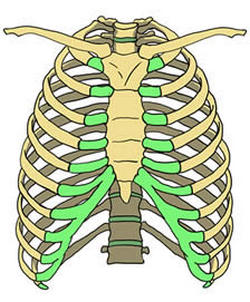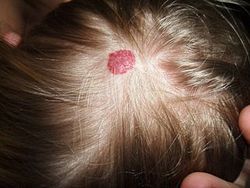
Medical Terminology Daily (MTD) is a blog sponsored by Clinical Anatomy Associates, Inc. as a service to the medical community. We post anatomical, medical or surgical terms, their meaning and usage, as well as biographical notes on anatomists, surgeons, and researchers through the ages. Be warned that some of the images used depict human anatomical specimens.
You are welcome to submit questions and suggestions using our "Contact Us" form. The information on this blog follows the terms on our "Privacy and Security Statement" and cannot be construed as medical guidance or instructions for treatment.
We have 1127 guests online

Georg Eduard Von Rindfleisch
(1836 – 1908)
German pathologist and histologist of Bavarian nobility ancestry. Rindfleisch studied medicine in Würzburg, Berlin, and Heidelberg, earning his MD in 1859 with the thesis “De Vasorum Genesi” (on the generation of vessels) under the tutelage of Rudolf Virchow (1821 - 1902). He then continued as a assistant to Virchow in a newly founded institute in Berlin. He then moved to Breslau in 1861 as an assistant to Rudolf Heidenhain (1834–1897), becoming a professor of pathological anatomy. In 1865 he became full professor in Bonn and in 1874 in Würzburg, where a new pathological institute was built according to his design (completed in 1878), where he worked until his retirement in 1906.
He was the first to describe the inflammatory background of multiple sclerosis in 1863, when he noted that demyelinated lesions have in their center small vessels that are surrounded by a leukocyte inflammatory infiltrate.
After extensive investigations, he suspected an infectious origin of tuberculosis - even before Robert Koch's detection of the tuberculosis bacillus in 1892. Rindfleisch 's special achievement is the description of the morphologically conspicuous macrophages in typhoid inflammation. His distinction between myocardial infarction and myocarditis in 1890 is also of lasting importance.
Associated eponyms
"Rindfleisch's folds": Usually a single semilunar fold of the serous surface of the pericardium around the origin of the aorta. Also known as the plica semilunaris aortæ.
"Rindfleisch's cells": Historical (and obsolete) name for eosinophilic leukocytes.
Personal note: G. Rindfleisch’s book “Traité D' Histologie Pathologique” 2nd edition (1873) is now part of my library. This book was translated from German to French by Dr. Frédéric Gross (1844-1927) , Associate Professor of the Medicine Faculty in Nancy, France. The book is dedicated to Dr. Theodore Billroth (1829-1894), an important surgeon whose pioneering work on subtotal gastrectomies paved the way for today’s robotic bariatric surgery. Dr. Miranda.
Sources:
1. "Stedmans Medical Eponyms" Forbis, P.; Bartolucci, SL; 1998 Williams and Wilkins
2. "Rindfleisch, Georg Eduard von (bayerischer Adel?)" Deutsche Biographie
3. "The pathology of multiple sclerosis and its evolution" Lassmann H. (1999) Philos Trans R Soc Lond B Biol Sci. 354 (1390): 1635–40.
4. “Traité D' Histologie Pathologique” G.E.
Rindfleisch 2nd Ed (1873) Ballieres et Fils. Paris, Translated by F Gross
"Clinical Anatomy Associates, Inc., and the contributors of "Medical Terminology Daily" wish to thank all individuals who donate their bodies and tissues for the advancement of education and research”.
Click here for more information
- Details
The term is a mix of two Greex root terms, [Pneum-] meaning "air" and [thorax] for "chest". The term [pneumothorax] means "air in the chest".
A pneumothorax occurs when the parietal pleura that lines the internal aspect of the chest and the visceral pleura that lines a lung are separated by a small amount of air that penetrates the thoracic cavity. This air causes the capillary action of the pleural fluid to fail, allowing for more air to enter the thoracic cavity and the lung to collapse.
Since the pleural cavities are separate, the collapse of one lung does not necessarily failure of the contralateral lung, except in a rare anatomical variation where both pleural cavities are communicated.
A pneumothorax can be spontaneous, with no apparent cause, or caused by trauma that allows the air to enter the thorax. If blood and air enter the thoracic cavity, the condition is then called a "pneumohemothorax".
Copyrighted image property of:CAA.Inc. Artist:D.M. Klein
- Details
This medical term is Greek and is composed of [ίδιος] (idios) meaning "self" or "one's own", something peculiar to a particular individual. This is probably why this root term is used for [idiot] or [idiocy]. The second portion of the word is also Greek [πάθος] (pathos) meaning "suffering", or "disease". The word [idiopathic] literally means "one's own disease".
The term is used today to denote a pathology that has no known cause.
- Details
[UPDATED] The medical term [hemangioma] is formed by two root terms and a suffix. The root term [hem-] arises from the Greek word [αίμα] (a?ma) meaning "blood", the second root term [-angi-] .from the Greek term [αγγείο] (angeio), meaning "vessel” and the suffix [-oma] (ωμα), also Greek, meaning "mass", "growth”, or "tumor". The term [hemangioma] then means a “mass of blood vessels”, a description not far from the truth.
A variation of the term is [hemangiomata], where the suffix [-omata] is plural, indicating multiple hemangiomas.
In general, a hemangioma can be described as a mass of blood vessels that can be convoluted, radiated, or swollen. Usually benign, hemangiomas appear in newborns and tend to evolve, involve, and disappear in the first ten years of life.
Other types of hemangiomas can be found in adults, with a tendency to be more prevalent in females than males. There are three types of hemangiomas described:
• Capillary hemangioma. Usually form skin patches known as “strawberry hemangiomas”. See image.
• Venous hemangioma. They are characterized by a “knot” or convoluted mass of veins. Since veins are usually more dilated than arteries, they are also known as “cavernous hemangiomas”. They can be found in a subcutaneous location or on internal organs, such as the liver.
• Arterial hemangioma. Formed by arteries, they tend to radiate and form a network of arteries, hence the term “plexiform hemangiomas”
• Vulvar hemangiomata. Multiple hemangiomas in the external female genitalia. For more information, click here
The image shows a small hemangioma in the scalp of a two-year old. Image by Cbheumircanl (Own work) [Public domain], via Wikimedia Commons
- Details
This term describes a structure that is composed of a multinucleated cytoplasm. It is either the result of the fusion of multiple adjoining cells, or the formation (by division) of multiple nuclei in a large cell.
Since cardiac muscle is formed by separate cells that are anatomically, mechanically, chemically, and electrically connected, the cardiac muscle has been called a "functional syncytium". Functionally, cardiac muscle works as a unit.
For those interested in the etymology of the word [syncytium], it arises from the Greek and its components are the prefix [syn-], meaning "together"; the root term [-cyt-], meaning "cell"; and the suffix [-ium], meaning "layer" or "membrane"
- Details
The root terms [-hem-] and [-hemat-] are both derivate from the Greek word [αίμα] (a?ma) meaning "blood". The same word and meaning applies to the suffix [-emia-]. Applications of these root terms include:
- Hematuria: The suffix [-uria] means "related to urine", or "urine". Refers to a condition where there is detectable blood in the urine
- Hematoma: The suffix [-oma] means "mass", "growth: or "tumor". A mass of blood that usually forms after trauma, a welt.
- Hemangioma: The root term [-angi-] means "vessel". The suffix [-oma] means "mass", "growth: or "tumor". A mass or a growth of blood vessels
Note: The links to Google Translate include an icon that will allow you to hear the Greek or Latin pronunciation of the word.
- Details
From the movie "Short Circuit" (1986):
Howard Marner: "Crosby, we're going to have to ask you to surrender the robot"
Newton Crosby: "Stat?"
Howard Marner: "Stat!"
Newton Crosby: "What does that mean, anyway?"
Howard Marner: "I don't know. But that's not the point"
The medical term [stat] arises from the Latin [statim] which means "immediately". By use and later abbreviation it has become [stat] with the same meaning. The term has somehow become overused in movie and television medical dramas with many people not knowing its meaning or etymology.
Note: The links to Google Translate include an icon that will allow you to hear the Greek or Latin pronunciation of the word.



